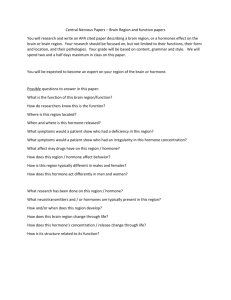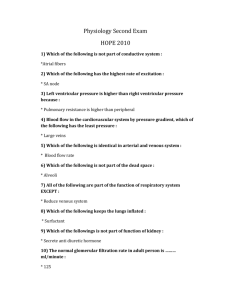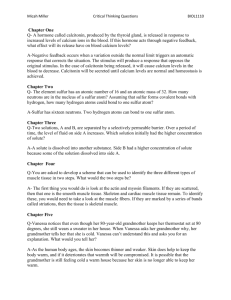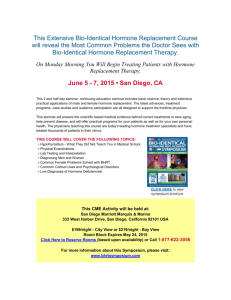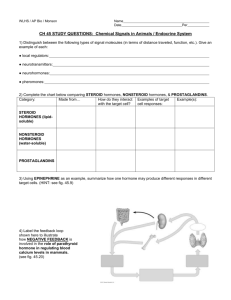File
advertisement
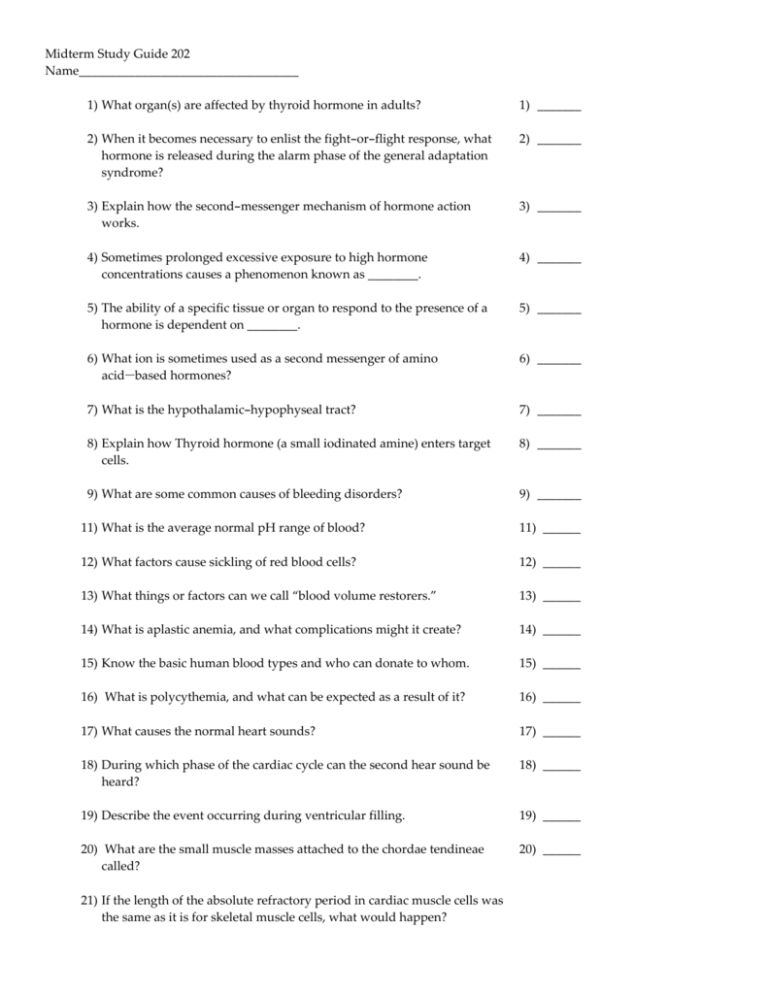
Midterm Study Guide 202 Name___________________________________ 1) What organ(s) are affected by thyroid hormone in adults? 2) When it becomes necessary to enlist the fight-or-flight response, what hormone is released during the alarm phase of the general adaptation syndrome? 3) Explain how the second-messenger mechanism of hormone action works. 1) _______ 2) _______ 3) _______ 4) Sometimes prolonged excessive exposure to high hormone concentrations causes a phenomenon known as ________. 4) _______ 5) The ability of a specific tissue or organ to respond to the presence of a hormone is dependent on ________. 5) _______ 6) What ion is sometimes used as a second messenger of amino acidbased hormones? 6) _______ 7) What is the hypothalamic-hypophyseal tract? 7) _______ 8) Explain how Thyroid hormone (a small iodinated amine) enters target cells. 8) _______ 9) What are some common causes of bleeding disorders? 9) _______ 11) What is the average normal pH range of blood? 12) What factors cause sickling of red blood cells? 13) What things or factors can we call “blood volume restorers.” 11) ______ 12) ______ 13) ______ 14) What is aplastic anemia, and what complications might it create? 15) Know the basic human blood types and who can donate to whom. 14) ______ 15) ______ 16) What is polycythemia, and what can be expected as a result of it? 16) ______ 17) What causes the normal heart sounds? 17) ______ 18) During which phase of the cardiac cycle can the second hear sound be heard? 18) ______ 19) Describe the event occurring during ventricular filling. 19) ______ 20) What are the small muscle masses attached to the chordae tendineae called? 20) ______ 21) If the length of the absolute refractory period in cardiac muscle cells was the same as it is for skeletal muscle cells, what would happen? 22) Explain the events that occur during the contraction of heart muscle. 22) ______ 23) If heart muscle is deprived of oxygen, what kind of damage would you expect? 23) ______ 24) What are some age related effects on heart muscle? 24) ______ 25) Explain the function of myocardial cells. 25) ______ 26) Why is the left ventricular wall thicker than the right? 26) ______ 27) What is the function of Aldosterone? 27) ______ 28) What are the baroreceptors in the carotid sinus and aortic arch are sensitive to? 28) ______ 29) Define hypovolemic shock. 29) ______ 30) What factors impact the velocity of blood as it circulates? 30) ______ 31) When is our thymus most active? 32) What is a lymphocyte and what does it do? 31) ______ 33) What effect does age have on the size of the thymus? 33) ______ 34) Which lymphatic structure drains lymph from the right upper limb and the right side of the head and thorax 34) ______ 32) ______ 35) Name the tonsils located at the base of the tongue. 36) List the functions of the lymphatic system. 36) ______ 37) What is/ causes delayed hypersensitivities? 37) ______ 38) Explain the role and/or function of Helper T cells 38) ______ 39) What are antigens? 39) ______ 40) What is a T cell? 40) ______ 41) Are there different types of T cells, if so what are they? 41) ______ 42) The amount of air that can be inspired above the tidal volume is called ________. 43) List the functional process performed by the respiratory system. 44) Nerve impulses from ________ will result in inspiration. 45) List the factors that promote oxygen binding to and dissociation from hemoglobin. 42) ______ 43) ______ 44) ______ 45) ______ 46) Short-chain triglycerides found in foods such as butterfat molecules in milk are split by a specific enzyme in preparation for absorption. What enzymes are responsible? 47) Which enzymes are specific for proteins? 46) ______ 48) List the types of papillae on the tongue that contain taste buds. 49) List the characteristics of the large intestine. 48) ______ 50) Chemical substances secreted by cells into the extracellular fluids and that regulate the metabolic function of other cells in the body are called ________. 50) ______ 51) How do Steroid hormones exert their action? 51) ______ 52) Explain how the parathyroid glands maintain adequate levels of blood calcium. 52) ______ 53) Thyroxine is a peptide hormone, but its mechanism is different from other peptide hormones. Explain it. 54) What is the pivotal molecule associated with the external surfaces of aggregated platelets and is involved in the intrinsic and extrinsic mechanisms of blood clotting? 55) Which blood type is called the universal donor? 53) ______ 56) List the characteristics of all leukocytes? 56) ______ 47) ______ 49) ______ 54) ______ 55) ______ 57) What might trigger erythropoiesis? 58) List all of the factors that influence heart rate? 59) Explain why low capillary pressures are desirable? 58) ______ 59) ______ 60) What would result in the dilation of the feeder arterioles and opening of the precapillary sphincters in systemic capillary beds? 60) ______ 61) What are the normal components of lymph? 61) ______ 62) What is the role of interferon in defense against disease? 62) ______ 63) What is the role if the pleura? 64) What role does the nose play in respiration? 63) ______ 65) What series of events can one expect after ingesting a high fat meal? 65) ______ 66) How does Pancreatic amylase get to the small intestine? 66) ______ 67) 67) ______ 64) ______ 68) The term for pain associated with deficient blood delivery to the heart that may be caused by the transient spasm of coronary arteries is ________. 69) What processes provide a long-term response to changes in blood pressure? 70) List the Digestive tract-associated lymphatic tissues. 68) ______ 71) The neurohypophysis or posterior lobe of the pituitary gland is not a true endocrine gland, why? 72) Which respiratory-associated muscles would contract if you were to blow up a balloon? 71) ______ 69) ______ 70) ______ 72) ______


